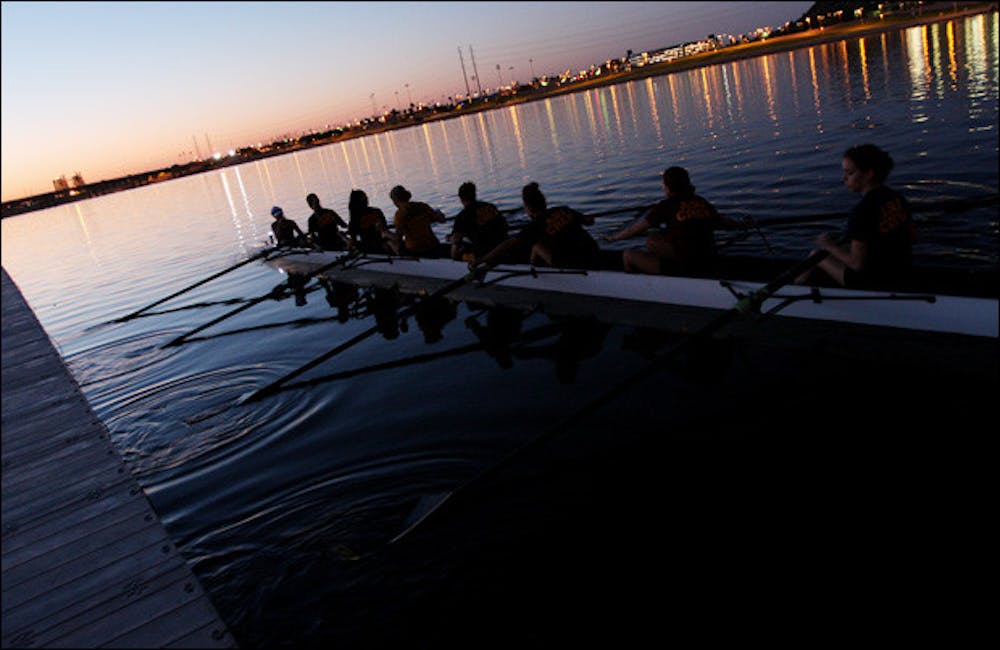You might have seen them, cutting the waves on Tempe Town Lake somewhere between five and eight a.m. However, chances are that you were still in bed and have no idea that there is a rowing team in the desert. Yet, the ASU Men’s and Women’s Crew team still exists without the knowledge of many.
The lack of awareness may be because the rowing team receives no funding from ASU, since it is a club team, and therefore less attention.
“We are not funded by the school in any way. We fundraise as much as possible and people can make a tax deductible donation to the American Collegiate Rowing Foundation,” Emily Burkett, the head women’s rowing coach, says.
Some fundraising that ASU Crew has done includes working at football game concession stands, zoo-lights at the Phoenix Zoo (where they helped direct people and checked for alcohol), working with Aramark (a dining and retail food service company at ASU) and hosting car washes. The money that cannot be raised is paid by the rowers.
“Rowing is a very expensive sport. Our boats can cost $30,000 with a few thousand for oars,” Bryant Flick, a rower and political science and Chinese sophomore says. “We have large travel fees to take a trailer full of boats to California and back, as well as house 30 to 40 rowers.”
“Even with all the fundraising we do, rowers still must pay $500 a semester,” Kristin MacLean says. However, the dues are broken into affordable payments for the rowers’ benefit.
The funding issue also means that the rowing teams play by a few different rules. Although MacLean says she does not look forward to fundraising and spending money, “I don’t think I would be able to compete if rowing were fully funded. I do not meet the physical expectations for an NCAA caliber rower.”
Besides the funding issues, recruiting new members to both the men’s and women’s teams can be difficult. “The majority of the people interested have no experience and don’t even know we exist until they see us around campus,” Chris Hays, a rower and business management senior, says.
However, the rowing team is very inclusive when it comes to recruitment. “We do not hold try-outs or cut anyone from the team. Basically, as long as you come to practice and give it your best try, then you are on the team,” MacLean says.
Practices are around 5 a.m. to 7 a.m. for women and 6 a.m. to 8 a.m. for men, MacLean says.
“It may sound early, but if you’ve ever tried to practice at noon, you know it is way too hot. Plus, the water is calmest in the morning. The calmer the water, the more enjoyable the rowing experience,” Hays says.
“The first week or two, early morning practices suck. Your body is not used to getting up early yet. However, after the first two weeks, it becomes a part of your routine,” MacLean says.
“There is a phrase in rowing: Rowers do more before 8 a.m. than most people do all day,” MacLean says.
Along with the early times, the practices themselves can be demanding.
“The conditioning at the start of the season is hard and scares a lot of people off. Honestly, it gets easier. Not that we do any less, but after two weeks, the practices we started with will feel like a warm-up,” Hays says.
“Rowing,” Flick says, “will build character but it will also reveal it.
“We have had plenty of ‘macho’ guys show up only to discover what real work is like. Let me put it this way: in the world of rowing, you get what you put into it,” Flick says.
However, crew is not all about hard work and no play.
“The team holds lots of parties and the like throughout the year, which are all usually resounding successes. This year we will be reviving the Mountain Goat Challenge, where the guy’s team climbs one of Arizona’s mountains and camps out,” Flick says.
After local races, the team often goes cliff jumping, and because most races are in California, there are a lot of road trips, MacLean says.
What separates the sport from others on campus goes beyond the funding issue, Flick says. In rowing, everyone is needed and no one is left out or substituted. Overall, “rowing is the ultimate team sport,” Flick says.
“[Rowing] is a sport where you cannot freeze someone out of the race. You cannot substitute them halfway through. From the start to the finish we are there for each other, if for no other reason than because the only way to get across that finish line first is to be perfect together,” MacLean says.
Upcoming races in the fall will be the Hot Head Regatta, which takes place at Tempe Town Lake, and the Head of the Charles Regatta, which is held in Boston, Massachusetts.
In the spring, one of the main races will be the American Collegiate Rowing Association national championships.
For more information about the team and contact information, you can visit the Web site at www.arizonastaterowing.com.
Reach the reporter at reweaver@asu.edu.





